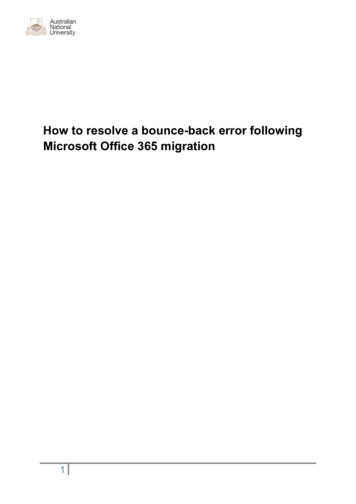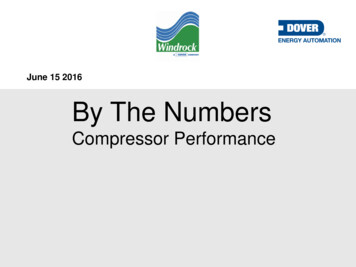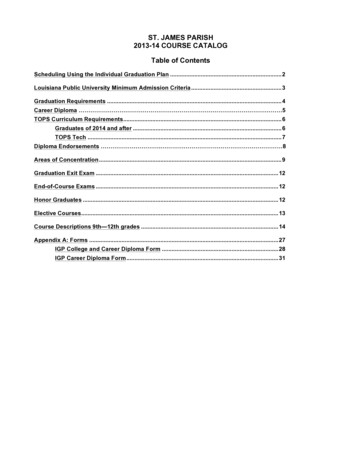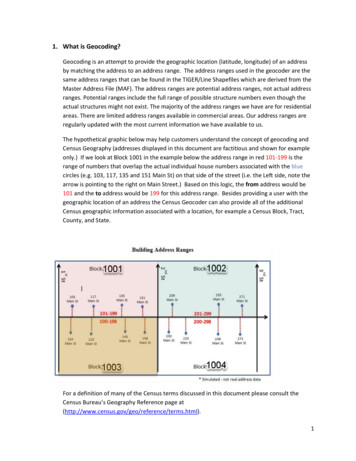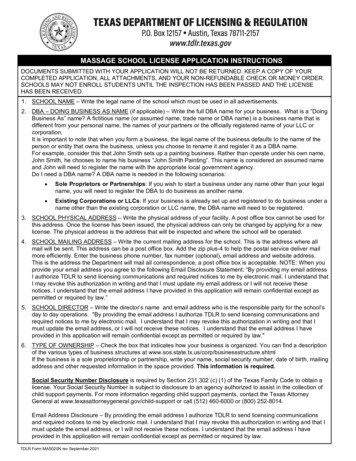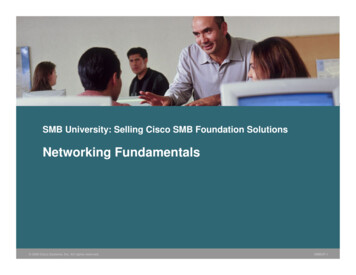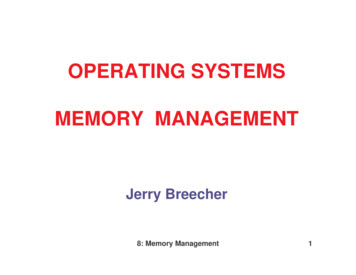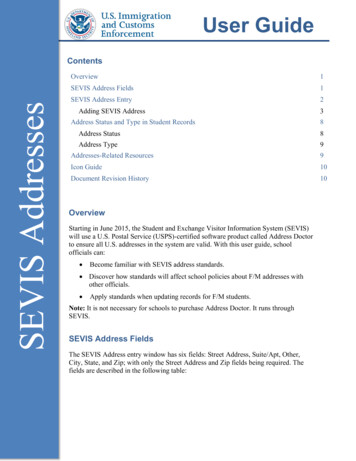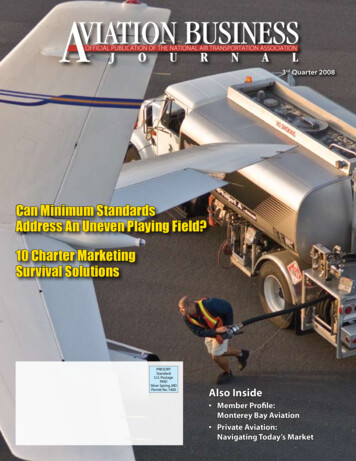
Transcription
3rd Quarter 2008Can Minimum StandardsAddress An Uneven Playing Field?10 Charter MarketingSurvival SolutionsPRESORTStandardU.S. PostagePAIDSilver Spring, MDPermit No. 1400Also Inside Member Profile:Monterey Bay Aviation Private Aviation:Navigating Today’s Market
2008 NetJets Inc. All rights reserved. NetJets Inc. is a Berkshire Hathaway company. NetJets andExecutive Jet Management are registered trademarks. The Marquis Jet Card is a registered service mark.A Berkshire Hathaway company.as defined by NetJets.As a wholly owned subsidiaryr of Berkshire Hathaway and the largestt privateaviaavi tion compap ny in thee world, we have the resources and commitment toensuensurere tthehe higighehestst ssafafetetyy ststanandadardds anand prp ovovidee thhe moostt rrele iablee prprivateeaviation serviice to ouur OwOwnnersrs, gigivivingg thethemm trtrueue pieiecece ooff mimindnd. AfAfteterr alall,l, yyouourrinvestmentt is only as good as the company that stands behind it. There arecertcertaiainn ththiningsgs OOnlnlyy NeNetJtJetetss cacann dodo.NETJETS FRACTIONAL JET OWNERSHIP PROGRAMS THE MARQUIS JET CARD EXECUTIVE JET MANAGEMMENNTN TJETS.COM 1.877.NETJETSNE
AviationBusinessJournal3rd Quarter 2008ISSUE 3 VOLUME 6Official Publicationof theNational Air TransportationAssociationChairman of the BoardPresidentDennis KeithJames K. CoyneJet Solutions LLCRichardson,TexasNATAAlexandria,VirginiaVice ChairmanTreasurerKurt F. SuttererJohnLotzMidcoast Aviation, Inc.Cahokia, IllinoisMonterey Bay AviationMonterey, CaliforniaImmediate Past ChairmanReedPigman, Jr.Texas Jet, Inc.FortWorth,TexasBoardof DirectorsChuck CoxJimMillerNorthern Air, Inc.GrandRapids, MichiganFlight OptionsCleveland, OhioJosephFazioAnnPollardAtlantic AviationTeterboro, NewJerseyShoreline AviationMarshfield, MassachusettsFrank MilianBruceS. VanAllenJet Source, Inc.Carlsbad, CaliforniaBBA Aviation Flight SupportOrlando, FloridaUneven PlayingFieldBy Colin BaneA fuel-pricing war in St. Croix in the U.S. Virgin Islands highlightsthe need for airport minimum standards and enforcement at airfieldsacross the U.S.Private Aviation: NavigatingToday’s MarketBy Dan TyburskiBy Michael J. RyanContributingEditorsJames K. CoyneMichael AncellShannonChambersLinda PylantEditorDavidW. AlmyEditorial DirectorAlanDarrowArt Direction/DesignTimWagnerAdvertisingManagerCheryl Stratos27In today’s changing marketplace with numerous financing options,aircraft buyers have much more to consider than just a few years ago.10 Charter MarketingSurvival SolutionsPublisher1931Marketing includes all the activities you perform, or could perform,to get and keep customers. Apply these charter marketing survivalsolutions to claim your share of the airspace.Member Profile: Monterey Bay AviationBy Paul Seidenman and David J. Spanovich37John Lotz, president of Monterey Bay Aviation, is defining aniche market by offering state-of-the-art pilot training and aircraft,expanded maintenance services, free flight safety seminars, andaircraft storage, with more to come.AdvertisingFor advertising information, call 703/212-4967or e-mail cstratos@ias-online.net.President’s Message By James K. CoyneProducedbyInsideWashington By Eric R. Byer103 Oronoco Street, Suite 200 Alexandria, VA 22314703/212-4967 www.ias-online.netSafetyWatch By Russ LawtonACSF News By Jacqueline RosserNewNATAMembersAdvertiser Index4226 King Street Alexandria, VA 22302800/808-6282 Fax 703/845-8176www.nata.aeroNATAPACMakes a DifferenceNATASafety 1st News711151741434445
PRESIDENT’S MESSAGEThe Power of the PoolThe Easiest Way toLower Insurance CostsEBy James K. Coyneveryone is looking for ways to lower overhead costs in today’s economy, and onegood place to start is with your insuranceprogram. Most of us find insurance policies confusing and are confounded by theunpredictable cycles in insurance markets.Buying insurance a few years ago was a painful process, especially in the post-9/11 aviation businesscommunity. Today, however, the aviation sector hasmore capacity and provides better value than riskmanagers have seen in years. Now is a good timeto see if your policies are right for you and yourcheckbook.NATA Membership PaysThe basic principle of all insurance is thatunderwriters sell policies to thousands of different companies and make money as long astheir total premiums and investments exceedtotal losses and costs. When they look at aparticular customer, they charge more whenthey are unsure or uncomfortable with therisk involved and less if the risk is more predictable and well-managed. Over the years,NATA has worked with insurance companies,agents, brokers, and our member companiesto find new ways to lower risks, reduce losses,and create programs that help our memberslower their insurance costs. Many NATAmembers have found that being part of anNATA insurance program can help them save thousands and thousands of dollars.The best example of this is the NATA Workers’Compensation Insurance Program, establishedmore than 30 years ago and today one of the largestprograms of its type in the nation. More than 650NATA member companies participate in the program, which is underwritten by USAIG, the largestaviation insurance company in the country.The fundamental principle of the NATA Workers’Aviation Business Journal 3rd Quarter 2008Comp Program is to create a pool of aviation servicebusinesses, thereby improving the managementof risk, losses, and expenses. Creating a pool of650 companies spreads the risk and makes it morepredictable. By concentrating just on NATA membercompanies, we’ve also been able to develop trainingand safety programs that have dramatically reducedthe number and severity of employee injuries, andBy concentratingjust on NATAmember companies, we’ve alsobeen able todeveloptrainingandsafety programs that havedramatically reducedthe number andseverity of employeeinjuries, andthus losses. The NATAprogramhas alsoallowedUSAIGtosave millions of dollars in marketingandsalesexpenses, which in turn has allowedthe programtoprovide aunique benefit toour members: a dividend!thus losses. The NATA program has also allowedUSAIG to save millions of dollars in marketing andsales expenses, which in turn has allowed the program to provide a unique benefit to our members: adividend!In fact, almost 60 million dollars in total dividends (technically known as “good experiencereturns”) have been earned by our members sincethe program was established. And with the help ofContinuedonpage87
President’s MessageContinued from page 7the NATA Safety 1st training programs and products,the losses in our pool have declined, on average,steadily over the past decade, allowing the goodexperience returns to grow to more than 6 millionlast year alone.Good Experience ReturnsOf course, not everyone can join the NATA program. Only NATA members are accepted, every applicant must meet USAIG’s underwriting standards,and companies in four states (North Dakota, Ohio,Washington, and Wyoming) are excluded becauseof state restrictions. But USAIG has learned after30 years of exceptional performance that NATAmembers are a good risk, and each member company, no matter how small, deserves to be treatedlike it was their biggest customer, because the NATAprogram is, in fact, USAIG’s biggest workers’ compcustomer.NATA program participants are also encouragedO M N ID I R E C T I O N A LThe Future ofGROUND SUPPORT is.306/% REGISTER to WIN a FREE G-30 ODVFor Contest Details Please Visit www.hammondscos.comNo Purchase Necessary. Hammonds 2008 ODV Giveaway starts on March 15, 2008 and ends onNovember 15, 2008 at 11:59 PM CT. Giveaway open to residents of the 50 U.S. (and DC) 18 years andolder. For entry and official rules go to www.HammondsCos.com. Void where prohibited. Sponsor isHammonds Technical Services, Inc., 910 Rankin Road, Houston, TX 77073.8to share a portion of their dividend with NATA tohelp underwrite our safety programs and seminars.Each participating member company receives apersonal invitation to contribute to NATA whentheir “good experience return” check is mailed inDecember, and I hope we can count on your support again this year.If you are not already part of the NATA insurancepool, you can ask your agent or broker to enrollyour company in the NATA program or call NATAdirectly at (800) 808-NATA. If you call me, I can tellyou how much your dividend check would typically be based on your company size and premiumamount (usually it’s between 10 and 20 percentof the annual gross premium). No matter howbig your company is or how long you’ve been inbusiness, I know you’ll be impressed. This is anoutstanding NATA benefit, and you’ll appreciate therates, the service, and especially the check at theend of the year.V E H I C L E SSAFERFASTERBETTERPlease visit our website to view videos, tolearn more about the exciting new world ofODV vehicle technology and to find out aboutthe different lines of ODV vehicles we offer. HAMMONDS TECHNICAL SERVICES910 Rankin Road Houston, Texas 77073Phone (800) 582-4224 Fax (281) 847-1857www.hammondscos.comAviation Business Journal 3rd Quarter 2008
Protecting your future every moment A Specialized Aviation & AerospaceInsurance Management Corporation“We think of AIR-SUR, INC. asthe risk management departmentwithin our own company.”– Danny LangstonPresident, Flightline Group“Anything comes up.it gets routed right to Air-Sur, Inc. They truly understandthe aviation market and speciality operations. We’ve been with them for 15years and with Tom Coughlin’s flying experience I know he and his teamhave a solid grasp of the risks we face. Their performance has earned therespect of our staff and our customers and I sleep well knowing that they arerepresenting us. With Air-Sur, Inc. it’s not just about getting the business.it’s about getting it done right.”— Danny LangstonTo find out if Air-Sur, Inc. is a good fit for your company call us today at800.342.3896. Our team of professionals is on hand to help.141 Sage Brush Trail Suite A Ormond Beach, FL 32174 w w w.air-sur.com
INSIDE WASHINGTONExercise Your ConstitutionalPrivilege on November 4ABy Eric R. Byers I write this column, we now, finally,have Vice Presidential candidates for bothparties. First, Democratic PresidentialNominee Barack Obama selected Sen.Joseph Biden (D-Del.) to be his runningmate for the fall campaign. SelectingBiden certainly shores up Obama’s weak record onforeign policy and places a bona fide ally of bluecollar workers, a segment of the electorate fromwhich Obama has struggled to gain support, on theticket. Obama’s selection of Biden also eliminatesone of his harshest critics during the campaign—Biden. More importantly, Biden’s selection putshim front and center as someone who, as a friendand colleague of John McCain in the Senate, cancounterbalance much of McCain’s experienceand mute those accusations that Obama has littlebackground dealing with foreign policy and defenseissues.Shortly thereafter, Sen. John McCain selectedGov. Sarah Palin (R-Alaska), a mother of five andgun-carrying pro-life Republican who defeatedincumbent Republican Governor Frank Murkowskiback in 2006. Palin has been widely credited forcleaning up some of the unnecessary spending thathas taken place with Alaskan politicians (she actually sold the gubernatorial plane) and has a bit of amaverick streak to her that many have embraced.Will Palin attract the Hillary Clinton female votethat is disgruntled with Obama? There certainly isthat potential. And the fact that she shores up theconservative base, who was quite miffed up untilher nomination, makes Palin an interesting pickthat could push McCain over the top in November.Unfortunately, this fall will likely showcase muchof the same that we have seen in previous elections, with attack ads, terribly boring debates wheremoderators ask the same questions disguised indifferent ways, and non-stop political commentaryad nauseam.The question on most American voters’ minds ishow will each of these candidates actually improve, if possible, the major factors that affect myAviation Business Journal 3rd Quarter 2008daily life, including theeconomy, fuel prices,and health care? Forour members, the question remains the same,how will each candidateaffect my business anddaily operations? Morethan ever, it is incumbentupon all voters, includingour members, to take amoment to review eachcandidate’s position onthe issues that affect them so that when they goto the polls on November 4 they cast an informedvote, rather than one based on what the politicalpundits have to say. One of the great privileges thatwe, as American citizens, have is the right to vote.We must take this Constitutional privilege seriously.A Closer Look at the CandidatesTo give members a start, I have done a little research into both campaigns, and having dealt withboth Senators’ offices on Capitol Hill, I have tried toprovide a fair synopsis of what our member companies might expect from each candidate if elected.I have provided links to the web pages of both ofthe candidates’ campaigns (www.johnmccain.com,www.barrackobama.com) so you can more thoroughly examine their respective positions.Clearly, transportation is not a major issue thateither campaign covers on its website. NATA recently submitted questionnaires to both campaignsasking for their responses to a number of questions on aviation issues affecting our membership.Whether we receive responses remains to be seen.However, I think there are some telling signs as towhat can be expected from each campaign on a fewof the issues.First, user fees. Although we are all growingweary of the subject, user fees will unfortunatelycontinue to be an issue as long as the legacy airContinuedonpage1211
InsideWashingtonContinued from page 11lines are in business. McCain has historically beena critic of those “fat cat” members of the businesselite who use business aviation for their travelingneeds. Ironically, McCain himself was a frequentflyer on corporate aircraft back to his home state ofArizona before the perimeter rule that forced himto connect through Chicago, St. Louis, Atlanta, orPittsburgh was abolished. After 9/11 and the abolishment of the perimeter rule, he was, of course,able to catch that direct flight back to Phoenix. McCain has lately been relatively silent on user fees,primarily because he has been campaigning forpresident and is no longer Chairman of the SenateCommerce Committee, which has jurisdiction overaviation issues. However, McCain has hinted in thepast at making general aviation pay more into theair transportation system. It is clear that the currentAs fuel prices continue toplummet, what realchange will take place? The best bet is that somesort of expansion in drillingwill be mandatedandboth candidates will hopon board.Republican administration firmly believes that userfees are appropriate, and there is no evidence that aMcCain administration would not follow suit.An Obama administration could more likely bean opponent to user fees than a proponent. TheNational Air Traffic Controllers Association, whichhas aligned with the GA community against userfees, endorsed Obama, giving him a large constituency of support. Rattling their cage would notendear him to this base. Obama’s Illinois colleaguein the Senate, Richard Durbin, also has been againstuser fees and has a substantial, direct influence onObama. However, the Clinton administration in thelate ’90s had a history of recommending user feeswithin its annual budget proposals. The verdict isstill out on Obama, but he is more likely to opposeuser fees than McCain, in my opinion.Second, general aviation security. Many of youhave heard about the new Large Aircraft SecurityProgram that the Transportation Security Administration could soon be offering as a proposed rule.How either a McCain or Obama administrationmight continue the implementation of this rule isunclear.McCain is a steadfast and ardent supporter ofAmerica’s defense and homeland security opera-12tions. Much of the debate on GA security to datehas been quietly spurred on by the United StatesSecret Service. Certainly, protecting the Presidentof the United States gives this agency some clout onthe issue. But as a Republican, McCain must securethe support of the millions of small businessesthroughout this country. Imposing burdensomenew security requirements for GA would certainlyrun contrary to traditional Republican values ofsupporting the growth of the small business community.Democrats on Capitol Hill have been fairly vocal that there continues to be loopholes in generalaviation security. The press has certainly latchedonto this belief and in many ways has driven thisagenda.At this point, there is no clear indication whateither candidate’s administration would do on GAsecurity. The McCain position can be viewed atwww.johnmccain.com. Click on national security.The Obama position can be found at www.barackobama.com. Click on homeland security.Third, energy. Fuel prices are up. The demandfor charter is generally down across the country. Itis clear that all the rhetoric on new alternative energy sources will foretell change of some type oncea new president takes office. McCain has pledgedto do more drilling. Obama has indicated he wouldbless that idea as well. But as fuel prices continueto plummet, what real change will take place? Thebest bet is that some sort of expansion in drillingwill be mandated and both candidates will hop onboard. Energy is one area on which both candidates’websites have a fair amount of information, and Iwould encourage you to review their positions. OnMcCain’s website, click on the energy button, andon Obama’s site, click on the energy and environment button.Finally, the economy. Both campaigns haveextensive economic plans including small businesscomponents. Reviewing each campaign website,it certainly seems that McCain has a more robustplan for small businesses, including tax reductions,lower health care costs, energy costs, and growthpotential. Obama’s plan would waive all capitalgains taxes for start-ups and small businesses “toencourage innovation and job creation.”Both proposals can be seen on the candidates’websites by clicking on the “economy” button.Please make sure you take your Constitutionalprivilege seriously. Take the time to research eachcandidate’s position on the issues important to youand head to the polls on November 4!Aviation Business Journal 3rd Quarter 2008
Base fter hours AOG:800-AOG-LINE(800-264-5463)As an aircraft maintenance professional, you don’t haveexcess time to spend researching, locating and managingparts. Instead, rely on Avgroup as your partner in support.Our experienced representatives, efficient logistics andextensive inventory add up to unsurpassed support thatgets you the right part at the right time, every time.FAA Repair Station #GT4R218M EASA.145.4187www.jetparts.com
Pilots loveFltPlan.comOver 80,000 active users and soaring!With constant new enhancements, we are the pilots’source for Flight Planning, FAA approved Weather,Flight Tracking and Airport/FBO Info. FltPlan.com,the largest flight planning service for business/corporate pilots in the U.S.!Info@FltPlan.com or call 1-800-FltPlanNowAvailable forthe iPhoneFlt Deck Airport/FBO Info Guideinternet access not required
WATCHWhen Will SMS Be Required?By Russ Lawton“When will SMS become a requirement?” is a question frequentlyasked of NATA Safety 1st. Well, itdepends on the part of the worldin which you operate. On January 1, 2009, the International CivilAviation Organization (ICAO) willrequire countries to make implementation of a safety management system (SMS) mandatory forany certificated operator. As youcan well imagine, many countries (including the U.S.) won’tmeet the January 2009 deadline.ICAO has circulated a proposal toextend the deadline to November2009; however, as of this writingthe January deadline remains ineffect.FAA Moving SlowlyMany countries will be forced tofile a “difference” from the ICAOrequirement as a result, meaningthey won’t be able to comply bythe 2009 deadline. (Canada andSingapore are the only countriesto declare their intent to meet theICAO deadline.) The U.S. will beone of the many countries forcedto file a difference as the FAAinches ever slowly to initiate rulemaking that would require U.S.airlines and charter operators toimplement SMS.The current FAA plan is topublish an advance notice ofproposed rulemaking (ANPRM)before the end of 2008. The operative word here is “advance,” asthe ANPRM is intended to solicitfeedback from operators, such asthe economic impact of and timerequired to implement SMS, etc.Any actual proposed rulemakingAviation Business Journal 3rd Quarter 2008for SMS is several years away.It’s interesting that FAA Associate Administrator for AviationSafety Nicholas Sabatini has declared that there will be one regulation developed for SMS, insteadof modifying existing regulations.This means there will be one comprehensive rule to require SMS forthe following: Scheduled Airlines (Part 121), On-demand Charter (Part 135),and Repair Stations (Part 145).As of this writing, there were noplans to include aircraft certification, Part 141 pilot schools, Part142 training centers, or sharedaircraft ownership (fractional) 91Koperations in the new regulation.But stay tuned, that could easilychange.The next step to make the “oneSMS rule” a reality is for the FAAto establish an aviation rulemaking committee (ARC), composedof FAA and aviation industry representative companies that wouldbe affected, to provide guidanceon how the new rule would bewritten and the implementationprocess. A notice of proposed rulemaking will follow once the ARChas completed its work, allowingmore time for the aviation industry to comment.The bottom line: Don’t expectto see a regulation in place until2013, unless the newly electedadministration decides to push itthrough sooner (not likely).You shouldn’t adopt the attitude,“With a regulation years away, I’mnot going to worry about this untilit becomes mandatory.” You’ll beway behind the proverbial powercurve if you do. It takes three tofour years to fully develop an SMS,which is why many companies arealready well into the developmentprocess.Another reason to get startedis that if you operate outside theU.S., your business will mostlikely be affected long before anynew FAA rule is adopted. Somecountries are already raising thepossibility of prohibiting anyonewithout an officially recognizedSMS from operating in their airspace. This policy could extend tolanding slots as well.Voluntary SMSThe FAA is developing a voluntarySMS implementation programto assist operators and head offpotential problems during international operations. Although theprogram is still a work in progresswith a draft advisory circular, anyoperator that participates andmeets the criteria would receiveFAA recognition for its SMS. Theform of recognition, however, isstill under consideration. NATAhas recommended that the FAAimplement a voluntary operationspecification (Ops Spec) for SMS,as this would provide both an official and internationally acceptedform of recognition.It’s more likely that the FAA willinstead issue a certificate of recognition. This might be more expedient because the FAA can neitherofficially “accept” nor “approve”an SMS program until it becomesrequired by regulation. A word ofContinued on page 4315
Building a global maintenance networkaround our clientsRecognized as world class maintenance and completions centers, Midcoast Aviation and Savannah Air Center (SAC) are cornerstonesof Jet Aviation’s growing maintenance network in North America. Together with our leading maintenance centers in Europe, theMiddle East and Asia, each of the Jet Aviation companies is committed to the unsurpassed safety and satisfaction of our clients.Whatever your aircraft type or size, whatever the work scope – routine inspection, unscheduled or heavy maintenance, overhaul oreven structural repair – you can rely on us to return it to you with minimal downtime and with complete confidence in a job well done.Personalized to Perfection. www.jetaviation.com www.midcoastaviation.com www.savannahaircenter.comJet Aviation l Basel l Dubai l Dusseldorf l Geneva l Hannover l Jeddah l Kassel lLondon Biggin Hill l Moscow Vnukovo l Singapore l Zurich l Midcoast Aviation lSt. Louis l Boston/Bedford l Chicago Palm Beach l Savannah (SAC) l Teterboro
NEWSThe AVSiS Safety AdvantageIBy Jacqueline Rossern the financial world, disclaimers aboundstating, “Past success is not an indication offuture performance.” Similarly, an accidentfree history is not necessarily a predictor ofan accident-free future. An aircraft operatorshould never be lulled into the false sense ofsecurity that, because it hasn’t happened yet, anaccident will never happen. It has been estimatedthat for each fatal accident as many as 360 incidentsoccur. Identifying and acting upon these incidentsis essential to ensuring the ongoing safety of anyaviation business endeavor.Encouraging Safety VigilenceThe Air Charter Safety Foundation (ACSF) hasannounced the availability of a revolutionarysoftware program for the on-demand and sharedaircraft ownership industry that addresses the needto maintain a constant watch for emerging safetyissues within their operations. This comprehensive computer program is called AVSiS, or Aviation Safety Information System, and its use allowsoperators to collect detailed safety event data foranalysis, response deployment, and success measurement and provides a tool for accounting for thecost savings realized by interventions.ACSF encourages all eligible operators to obtain and implement AVSiS. To ensure widespreaddeployment to as much of the industry as possible, ACSF is offering the program at absolutely nocharge to all Part 135 operators and 91K programmanagers. ACSF is also providing the necessarycomputer database structure. Each user accountwill include unlimited storage of AVSiS data onsecure servers maintained by ACSF.AVSiS deployment will allow operators and program managers to establish a non-punitive eventreporting program, which is widely considered essential to a positive safety culture, and to maintainconstant safety awareness in their company.ACSF has developed AVSiS to be directly applicable to charter and shared aircraft programsand offer the valuable benefit of remote reportingcapabilities, so employees may file information ona safety event from any authorized computer that isAviation Business Journal 3rd Quarter 2008connected to the Internet.Users of AVSiS receive access to numerous features, including: Pilots, line employees, maintenance staff and allother employees are empowered through AVSiS toreport safety information to the company safetymanager for development of mitigation and intervention strategies. AVSiS gives users the ability to differentiate between types of safety events. Each event is loggedas either an incident (event with a direct safetyimplication) or occurrences (events which mayhave resulted in an incident). AVSiS enables the user to categorize the eventand apply a severity rating (important for SafetyManagement System (SMS) programs). AVSiS tracks event investigations and flags overdue items. The safety manager may make recommendations and monitor implementation ofsafety interventions. Safety managers can also use AVSiS to providestatistical reports and graphical trend analyses byincident type, aircraft model location, or otherspecified field.Benefits for the Entire IndustryIn addition to the individual user benefits, the database structure provided by AVSiS will allow ACSFto conduct high-level analysis of the data to identifyindustry trends and publish intervention strategieswhere appropriate, while maintaining the privacyof the unique users. As use of AVSiS grows, theentire industry will benefit from the trend analysisthat ACSF can conduct to head off safety concernsbefore accidents occur.More information on AVSiS is available on theACSF website at www.acsf.aero/avsis. It is our hopeat ACSF that AVSiS will be used by all eligible operators. By providing the software and database storageas a free service to the industry, there is no reasonnot to use and benefit from this program. Visit ourwebsite today, complete our simple on-line registration, and you will be on your way to having adramatic, positive impact on your company’s safetyculture.17
Uneven FieldA fuel-pricing war in St. Croix in the U.S. Virgin Islands highlights the need forairport minimum standards and enforcement at airfields across the U.S.WBy Colin Baneith jet fuel prices soaring and competition increasing between FBOsat airports around the country,NATA is finalizing a new minimumstandards document to help alleviate confusion and conflict at placeslike the Henry E. Rohlson Airport in St. Croix inthe U.S. Virgin Islands, where a fuel pricing war isresulting in the biggest fuel price disparity betweenFBOs at any airport in the country.Bohlke International Airways (BIA) has beenoperating in the U.S. Virgin Islands since WilliamBohlke, Sr., started an air charter company in St.Croix in 1959 and began selling Texaco-brandedfuel from its tank field in 1963. Nearly 50 years andtwo generations later, as Bill Bohlke, Jr., preparesto hand off the family business to his son WilliamR. Bohlke, III, BIA is one of the highest rated FBOsin the Caribbean, ranking first in 2007 and consistently in the top three in the region by Pro PilotMagazine’s Pilot Survey.Despite that reputation, Bohlke said increasedcompetition and lack of minimum standards enforcement at the airport is threatening his business.As the airport has opened its field to leases fromtwo competing operators to increase its revenuestream, Bohlke said the playing field is now tiltedagainst him because his competitors are not beingheld to the s
The Marquis Jet Card is a registered service mark. NENTJETS.COM 1.877.NETJETS NETJETS FRACTIONAL JET OWNERSHIP PROGRAMS THE MARQUIS JET CARD EXECUTIVE JET MANAGEMMENNT . A fuel-pricing war in St. Croix in the U.S. Virgin Islands highlights the need for airport minimum standards and enforcement at airfields across the U.S.


